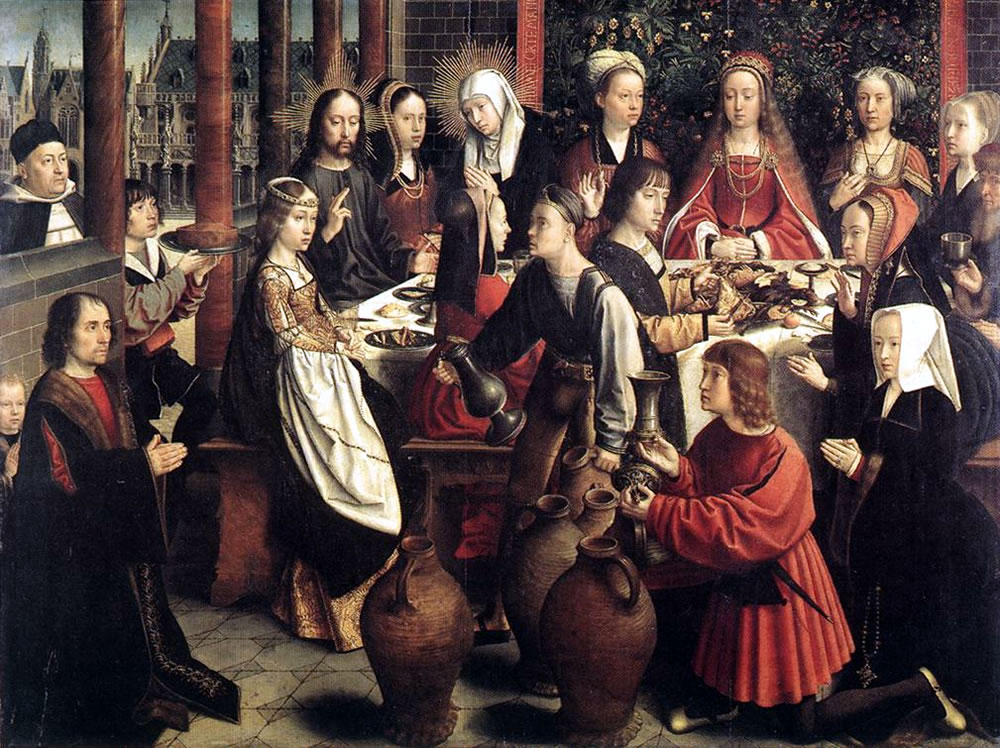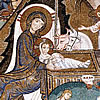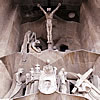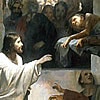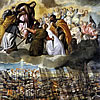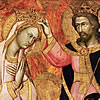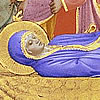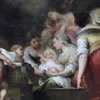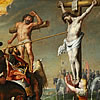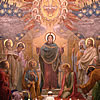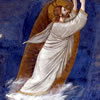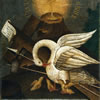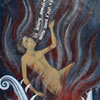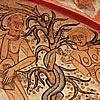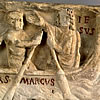Contemplating the Mysteries of the Holy Rosary
On October 16, 2002, Saint Pope St. John Paul II shared with the faithful his apostolic letter entitled Rosarium Virginis Mariae (The Rosary of the Virgin Mary). In that letter, the word “contemplate” appears sixty-seven times. The way he uses the word does not mean infused contemplation, which is something that cannot be produced, but “to think about,” or “to reflect on.” He encourages us to ponder on the mysteries because, as he explains:
To recite the rosary is nothing than to immerse oneself in the contemplation, with Mary, the face of Christ. Without this contemplative dimension, it would lose its meaning.
He isn’t the first pope to suggest this. In the Apostolic Exhortation Marialis Cultus, Pope Paul VI warned that:
Without contemplation, the rosary is a body without a soul, and its recitation runs the risk of becoming a mechanical repetition of formulas…
Both popes then, one of whom is a saint, urge us to pray the rosary by emphasizing the contemplation more than the vocal prayers.
This might come as a shock to most of us who have been taught to concentrate on every word that is being said. It might also seem odd to think about something while saying the rosary because praying vocally and reflecting on something else does not instinctively go together. But, that is exactly what is being advocated. Blessed Archbishop Fulton Sheen, whose cause for sainthood has been revived, has this to say about the rosary:
It is a prayer that has a beautiful combination. I don’t think there is any prayer in the world that has the combination of the rosary. First of all, it is vocal: we say some prayers with our lips. Secondly, it’s mental because as we say, for example, the Hail Mary, [but] we are not so much concentrating on the Hail Mary; we are thinking about the mystery.
It is very much as if we were in a theater, and there’s beautiful music in [the] back of a speaking voice. Now the speaking voice is the Hail Mary; the music behind it is the meditation.
Then in addition to the mental of the prayer (the thought) and the vocal (the prayer itself), there is the physical – the movement of the fingers over the beads.
Similarly, the popular and YouTube sensation, Bishop Barron, explains that vocal prayer is meant to slow us down, and the repetitive prayers of the rosary are meant to bring us to a meditative state. Adding to that, Pope Benedict XVI also said:
…repetition is a way of settling oneself into the rhythm of tranquility. It’s not so much a matter of consciously concentrating on the meaning of each single word, but allowing myself on the contrary to be carried away by the calm repetition and of steady rhythm. So much more so, since this text does not lack content. It brings great images and visions and above all the figure of Mary – and then, through her, the figure of Jesus – before my eyes and in my soul.
If we are to imitate these saints and theological giants in the way they pray the rosary, we would do three things at the same time: pray vocally, use the beads as a counter (to know when to say the Our Father, Hail Mary, and Glory Be), and reflect on the current mystery we are praying.
It may take time to learn to pray the rosary this way, but nothing is easy at first. Here are some suggestions on how to do this.
- In Rosarium Virgininis Mariae, St. Pope John Paul II urges us to follow Mary’s contemplation, which does not just remember, but makes present the works of God. After announcing each mystery (for example, after saying, “the third joyful mystery is the nativity,”) put yourself in the scene as if it were happening in front of you. First, construct the scene as if you were watching a movie. Imagine who are in the scene. What are they doing or saying, and how are they doing these? Imagine the setting. What is it like? Is it a lonely place, or is the scene brimming with people? Is it day? Night? Are the characters inside our outside? What does it smell like? Are there any sounds in the background like crickets, birds, or a strong wind? Imagine the scene as best you can with all your senses. Then, actually put yourself in the scene by being one of the silent characters (or a fly on the wall) who is quietly witnessing the scene. By doing this, we emulate the apostles who witnessed Christ’s Transfiguration, so we can say with them, “it is good for us to be here!” (Luke 9:33)
- As you say the vocal prayers, let your mind move through the scene. For example, in the mystery of the nativity, we can start with Mary who is sitting on a donkey making their way to Bethlehem with Joseph. We can imagine that Joseph is very optimistic about having a place to stay in Bethlehem because he has relatives there; it is his ancestral town after all. On the second Hail Mary, we can imagine them arriving in Bethlehem and receiving the bad news from Joseph’s relatives who cannot take them in because they have no room – not that they don’t want to accommodate them, but the influx of transients brought about by the census has filled every available space. On the third Hail Mary, even when Joseph goes to the local inns, they are fully occupied and they are turned away. On the fourth Hail Mary, we can imagine Mary beginning to go into the labor, so Joseph must get any available place for as long as it is private because the act of giving birth requires it. So, Joseph and Mary settle for the only available space no other human would take: an animal stable inside a dark and smelly cave. And so on.
- As we contemplate each scene, Saint John Paul II tells us to “read” Christ to “discover his secret, and to understand his message.” That means we must put Christ in each of the mysteries of the rosary. In the Annunciation, for example, he is incarnated inside Mary’s womb when she says, “Behold I am the handmaid of the Lord, be it done to me according to your word.” He is inside Mary’s womb when she visits Elizabeth. Together with the Father, Christ sends the Holy Spirit on Pentecost. Christ receives his mother at her Assumption. And Christ enthrones his mother when she becomes queen, the way Solomon does with his mother Bathsheba. The Rosary is a Christocentric prayer, but it is Marian in the sense that it echoes her Magnificat – that wonderful burst of joy in proclaiming God’s marvelous work. By putting ourselves by her side as we relive the mysteries in the rosary, she will undoubtedly bring us to her son in each of them as we say the vocal prayers with joy and adoration.
- Fill in what scripture doesn’t explicitly mention. Scripture wasn’t meant to record all the details, so we can conclude that many unimportant minutiae were purposely left out. When reflecting on the mysteries, we can ponder on these missing details. For example, when Joseph and Mary lost Jesus in the temple, it would be interesting to imagine where he slept and what he ate for three days. When meditating on the Crowning of Thorns, for example, we can imagine why Christ doesn’t instinctively remove it. Maybe he has no more strength after the scourging, or maybe the answer is simpler: his hands were in shackles. Let your mind actively investigate the scenes and this will give it more texture and vivid reality.
- Consider a different angle. As we pray this way, we will usually have a certain “camera angle” when “witnessing” these scenes. It might be good to experience it from a different angle too. So, imagine you are a movie director and situate the camera in a different place. For example, if we imagine the Annunciation with Mary and Gabriel in the foreground and there is a window behind them, try viewing the scene as if you were a person viewing the scene from the window. Imagine what the room looks like from that angle. This is a good technique so our minds are constantly re-imagining the scenes to keep them from getting stale.
- Read the Gospels. To create vivid images in our heads, our minds must be fertile. The way to do this is to read the Gospels because they tell about Christ and what he taught, thought, and did. It is difficult to produce something out of nothing; we must have a starting point and let our imagination do the rest. Read the Gospels prayerfully and try to get more detail out of them. When we do this, it is almost sure to produce images when we reflect on the scenes of the different mysteries when we pray the rosary.
- Let God touch you. As we pray this way, there may be times that a scene we are meditating on may inspire us or make us emotional. We can stop and stick with that scene for a while. This is the way God talks to us and it would be nice to respond, as one should do when spoken to. We can respond vocally with our own words, but tears, laughter, or an intense inspiration or resolution can be enough for God knows what is in our hearts. When this is over, we can return to where we left off in the rosary. Saint Pope John Paul II sometimes had to stop in between mysteries because they got him very emotionally exhausted – not that that is the goal, but it does happen to saints and popes and it can happen to us too.
Persevere. Don’t get discouraged if you get distracted or forget to ponder on the mysteries. The important thing is to pray the rosary with perseverance. Never give in to the temptation thinking you are not good at it. You are not alone because we all struggle in prayer. Instead, ask your guardian angel to help you pray, or even better, to join you. He will help you keep focused and in the proper mindset of prayer. Don’t stop praying the rosary for its heartbeat is the phrase “blessed is the fruit of your womb, Jesus.” Let it beat with yours in praise for God.
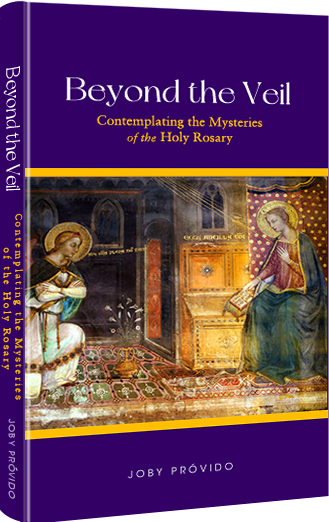
Beyond The Veil: Contemplating the Mysteries of the Holy Rosary
Prayer giants like Pope St. John Paul II, Pope Paul VI, Bl. Archbishop Fulton Sheen, and Bishop Robert Baron advocate that we contemplate on the mysteries of the rosary while we say the vocal prayers. Unfortunately, there are not many books that teach us how to do this. Beyond the Veil comes to the rescue by suggesting seven ways we can pray the rosary the way it was intended.
The larger part of the book offers mental images for each of the mysteries we can use in our contemplation, for how can we imagine the scenes in the rosary if we don’t know about them?
Get your copy now either in Hardbound, Paperback, or Kindle
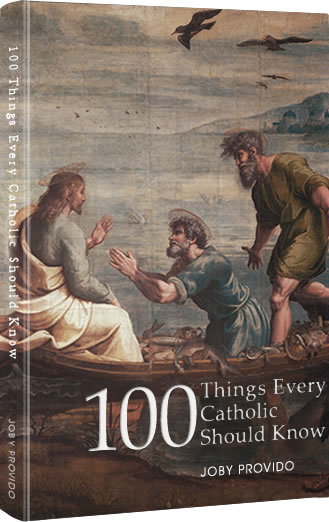
100 Things Every Catholic Should Know
Whether or not you are new to the Catholic Church, or struggling, or lapsed, or dynamically involved, this book will enlighten you with the essentials of the Faith that have been handed down to us by the apostles.
Each of the 100 topics is easy to read and distilled into bite-sized portions. Through cross-referencing, the book also shows how the topics are interrelated. Those who are new to the Faith will find this book an edifying handy reference, and those who have simply forgotten will find it a great review material that might spark a new love for God and religion.
Get your copy now either in Hardbound, Paperback, or Kindle

A Sky Full of Stars
Know Our Lady through her Titles in the Litany
The Church helps us understand who Mary is by honoring her with different titles in the Litany of the Blessed Virgin Mary. Unfortunately, over time and difference of culture, we might not grasp what it is the Church is ascribing to her and lose that opportinity to get to know her.
In A Sky Full of Stars, each title of the Litany is explained so we get know Mary more and fall in love with her all over again.
Get your copy now either in Hardbound, Paperback, or Kindle

Beyond the Veil
Contemplating the Mysteries of the Holy Rosary
Prayer giants like Pope St. John Paul II, Pope Paul VI, Bl. Archbishop Fulton Sheen, and Bishop Robert Baron advocate that we contemplate on the mysteries of the rosary while we say the vocal prayers. Unfortunately, there are not many books that teach us how to do this. Beyond the Veil comes to the rescue by suggesting seven ways we can pray the rosary the way it was intended.
The larger part of the book offers mental images for each of the mysteries we can use in our contemplation, for how can we imagine the scenes in the rosary if we don't know about them?
Get your copy now either in Hardbound, Paperback, or Kindle
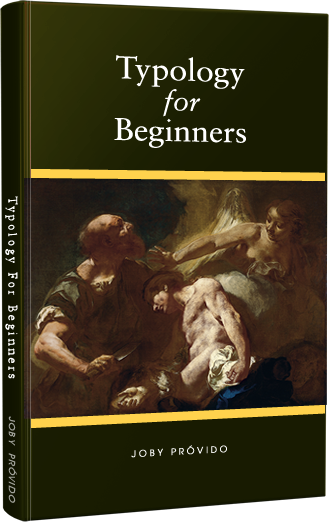
Typology for Beginners
A Catholic Perspective on understanding the New Testament through the Old Testament
First-century Jews converted to Christianity in droves because of the way the New Testament was written to show Jesus was the Messiah promised by the Old Testament. We also learn about how Mary is the New Eve and the Ark of the Covenant in the way the writers portray her.
Through typology, the patterns that connect the Old and New Testaments make the Bible stories more accessible so that one becomes excited to read Sacred Scripture again.
Get your copy now either in Hardbound, Paperback, or Kindle


